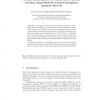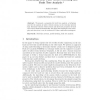253 search results - page 3 / 51 » Using Fault Modeling in Safety Cases |
EDCC
2005
Springer
13 years 11 months ago
2005
Springer
Abstract. In this paper we present the formal safety analysis of a radiobased railroad crossing. We use deductive cause-consequence analysis (DCCA) as analysis method. DCCA is a no...
CASES
2011
ACM
12 years 5 months ago
2011
ACM
Cost pressure is driving vendors of safety-critical systems to integrate previously distributed systems. One natural approach we have previous introduced is On-Demand Redundancy (...
FM
2003
Springer
13 years 10 months ago
2003
Springer
We present a semantics for fault tree analysis, a technique used for the analysis of safety critical systems, in the real-time interval logic Duration Calculus with Liveness and sh...
ISCAPDCS
2001
13 years 6 months ago
2001
Reliable communication in injured hypercubes with faulty links/nodes using directed safety levels is studied in this paper. In this approach, each node u in an n-dimensional hyper...
DSN
2002
IEEE
13 years 10 months ago
2002
IEEE
Designing applications with timeliness requirements in environments of uncertain synchrony is known to be a difficult problem. In this paper, we follow the perspective of timing ...


